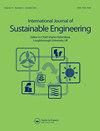The potential contributions of universal and ubiquitous wireless power transfer systems towards sustainability
IF 3.6
Q3 GREEN & SUSTAINABLE SCIENCE & TECHNOLOGY
International Journal of Sustainable Engineering
Pub Date : 2021-10-08
DOI:10.1080/19397038.2021.1988187
引用次数: 7
Abstract
ABSTRACT Different wireless power transfer (WPT) technologies using inductive, capacitive, or optical coupling, and microwaves have been theoretically investigated and many have been employed in commercial products. WPT technologies have their own advantages and drawbacks and have been individually studied. This article envisions a concept of universal and ubiquitous wireless power transfer (U2WPT), in which power can be wirelessly transferred between any entity, whether stationary or in-motion, as long as they are equipped with appropriate energy transmitters and receivers. The realisation of such a U2WPT concept allows for the analysis of the sustainability of existing WPT systems in a unified manner, and to potentially overcome their limitations and engender greater energy mobility, flexibility, and sustainability. In addition, market mechanisms for U2WPT systems are introduced, along with an analysis of the benefits engendered in terms of economic, environmental, human and social outcomes, and improvement of energy and transportation systems. Finally, a discussion on the realisation of the U2WPT concept including policy implications, and recommendations for future research directions essential to their deployment is presented.普遍和无处不在的无线电力传输系统对可持续发展的潜在贡献
利用电感、电容或光耦合和微波的不同无线电力传输(WPT)技术已经在理论上进行了研究,许多技术已经应用于商业产品。WPT技术各有优缺点,已被单独研究。本文设想了一个通用和无处不在的无线电力传输(U2WPT)的概念,其中电力可以在任何实体之间无线传输,无论是静止的还是运动的,只要它们配备了适当的能量发射器和接收器。实现这样一个U2WPT概念,可以以统一的方式分析现有WPT系统的可持续性,并有可能克服其局限性,产生更大的能源流动性、灵活性和可持续性。此外,还介绍了U2WPT系统的市场机制,并分析了在经济、环境、人类和社会结果方面产生的效益,以及改善能源和运输系统。最后,讨论了U2WPT概念的实现,包括政策影响,并提出了对其部署至关重要的未来研究方向的建议。
本文章由计算机程序翻译,如有差异,请以英文原文为准。
求助全文
约1分钟内获得全文
求助全文
来源期刊

International Journal of Sustainable Engineering
GREEN & SUSTAINABLE SCIENCE & TECHNOLOGY-
CiteScore
7.70
自引率
0.00%
发文量
19
 求助内容:
求助内容: 应助结果提醒方式:
应助结果提醒方式:


